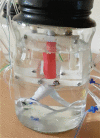Experimental Laboratory Modeling of Choroidal Vasculature: A Study of the Dynamics of Intraoperative Choroidal Hemorrhage during Pars Plana Vitrectomy
- PMID: 34702023
- PMCID: PMC8558693
- DOI: 10.4274/tjo.galenos.2020.64927
Experimental Laboratory Modeling of Choroidal Vasculature: A Study of the Dynamics of Intraoperative Choroidal Hemorrhage during Pars Plana Vitrectomy
Abstract
Objectives: Choroidal hemorrhages (CH) result from rupture of choroidal vessels leading to extravasation of blood into the suprachoroidal space. In this study, we aimed to understand the hemodynamics of CH by developing a purpose-built scale model of the choroidal vasculature and calculating stress levels in the model under different conditions.
Materials and methods: We modeled the choroidal vasculature using a rubber tube 10 cm in length and 1 cm in diameter that was wrapped with conductive thread to enable the measurement of stress at the walls of the tube. Stress levels across the tube were continuously measured under different systemic intravascular blood pressure levels (IVP), intraocular pressure (IOP) levels, and distortion.
Results: Stress values across the choroidal vessel model correlated negatively with IOP and positively with IVP and distortion. All correlations were statistically significant (p<0.05) and were stronger when the model was filled with expansile tamponade compared to non-expansile tamponades. Distortion showed the strongest correlation in terms of increasing stress across the model, while IVP showed stronger correlation compared to IOP. Raising IOP to counteract the stress in the model was effective when the stress in the model was secondary to increased IVP, but this approach was not effective when the stress in the model was caused by distortion.
Conclusion: Excessive distortion of the globe during surgical maneuvers could be the primary reason for the rarely observed intraoperative CH. Non-expansile ocular tamponade provides better support for the vascular bed against CH and should be the recommended choice of tamponade in patients with existing CH. Increasing IOP excessively is of limited effect in preventing CH in vessels that are under stress as a result of distorting surgical maneuvers.
Keywords: Choroid hemorrhage; choroid; suprachoroidal space; vitrectomy.
Conflict of interest statement
Figures




Similar articles
-
Suprachoroidal hemorrhage during pars plana vitrectomy.Curr Opin Ophthalmol. 2001 Jun;12(3):179-85. doi: 10.1097/00055735-200106000-00006. Curr Opin Ophthalmol. 2001. PMID: 11389343 Review.
-
Intraoperative B-scan ultrasonography and pars plana vitrectomy for severe open globe injury with hemorrhagic retinal and choroidal detachment.Graefes Arch Clin Exp Ophthalmol. 2017 Nov;255(11):2287-2291. doi: 10.1007/s00417-017-3771-1. Epub 2017 Aug 30. Graefes Arch Clin Exp Ophthalmol. 2017. PMID: 28856428
-
ACUTE INTRAOPERATIVE SUPRACHOROIDAL HEMORRHAGE DURING SMALL-GAUGE PARS PLANA VITRECTOMY.Retin Cases Brief Rep. 2018 Fall;12 Suppl 1:S9-S11. doi: 10.1097/ICB.0000000000000659. Retin Cases Brief Rep. 2018. PMID: 29155697
-
Perioperative choroidal hemorrhage at pars plana vitrectomy. A case-control study.Ophthalmology. 1993 May;100(5):699-704. doi: 10.1016/s0161-6420(93)31586-1. Ophthalmology. 1993. PMID: 8493013
-
Surgical Management of Choroidal Diseases.Klin Monbl Augenheilkd. 2021 Sep;238(9):980-987. doi: 10.1055/a-1554-5496. Epub 2021 Aug 20. Klin Monbl Augenheilkd. 2021. PMID: 34416789 Review. English, German.
References
-
- Wolter JR. Expulsive hemorrhage: a study of histopathological details. Graefes Arch Clin Exp Ophthalmol. 1982;219:155–158. - PubMed
-
- Williamson TH. Intraocular Surgery: A Basic Surgical Guide. Switzerland; Springer International Publishing. 2016:87–110.
-
- Gressel MG, Parrish RK, Heuer DK. Delayed nonexpulsive suprachoroidal hemorrhage. Arch Ophthalmol. 1984;102:1757–1760. - PubMed
-
- Purcell JJ Jr, Krachmer JH, Doughman DJ, Bourne WM. Expulsive Hemorrhage in Penetrating Keratoplasty. Ophthalmology. 1982;89:41–43. - PubMed
-
- Manschot WA. The pathology of expulsive hemorrhage. Am J Ophthalmol. 1955;40:15–24. - PubMed
MeSH terms
LinkOut - more resources
Full Text Sources
Miscellaneous
